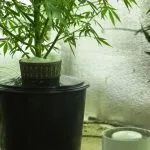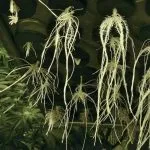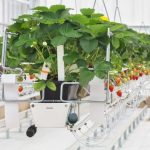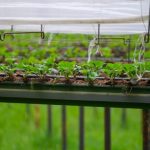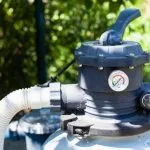Hydroponics systems can range from simple setups involving a single plant to advanced systems used by commercial growers. The simplest method of active hydroponics is the Deep Water Culture (DWC) system, while the Recirculating Deep Water Culture (RDWC) system adapts the concept to allow you to scale up operations and grow larger plants.
In DWC, your plants’ roots are suspended in a nutrient-rich solution in a single container, with an air pump providing oxygen to the roots. This method utilizes only one reservoir, making it simpler and more affordable. On the other hand, RDWC features multiple containers connected to a single main reservoir, allowing you to grow many plants at once. This system has a more efficient nutrient solution recirculation process, reducing the risk of temperature fluctuations that may affect plant growth.
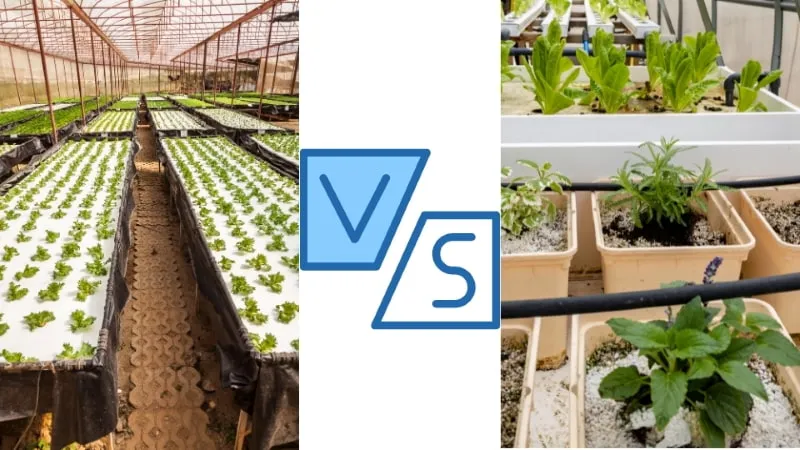
As you explore the world of hydroponic gardening, consider the advantages and drawbacks of each method to make an informed decision. With careful planning and a clear understanding of the differences between DWC Vs RDWC hydroponics, you’ll be well-equipped to create the perfect environment for your plants to thrive.
Understanding DWC and RDWC
In this section, you’ll learn about the difference between DWC and RDWC, two popular hydroponic growing methods. We’ll explore the key aspects of each approach, helping you get a better understanding of which one might be the best fit for your growing needs.
Deep Water Culture (DWC)
Deep Water Culture (DWC) is a straightforward hydroponic technique that grows plants with their roots immersed in an aerated nutrient solution. The plants are anchored in a floating platform or net pots, allowing the roots to access water, nutrients, and oxygen directly. We explain in detail how deep water culture works but here are some key features of DWC:
- Simplicity: You’ll find that DWC systems are fairly easy to set up and operate. All you need is a container, air pump, air stone, water, nutrients, and plants. If you want to scale up, you replicate the same system.
- Efficiency: The continuous access to nutrients and oxygen allows the plants to focus on growth, leading to quicker maturation and larger yields.
- Fewer complications: DWC systems often experience fewer problems with pH fluctuations, nutrient imbalances, and pests compared to soil-based methods.
Floating Raft or Deep Water Culture Diagram
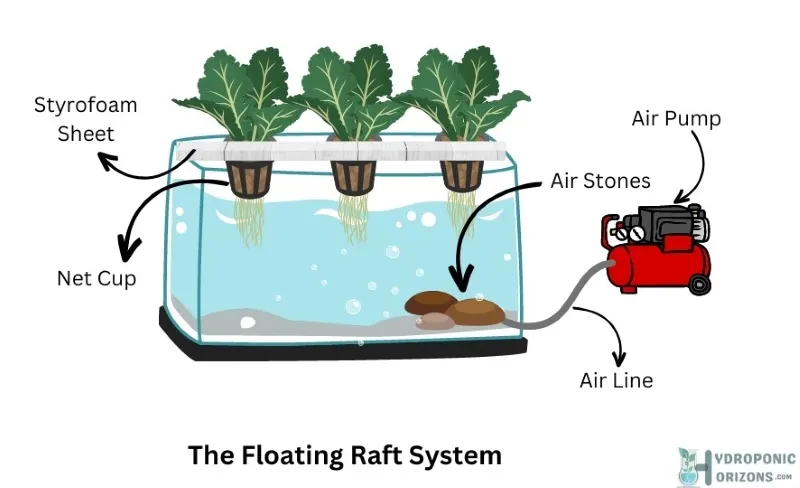
Recirculating Deep Water Culture (RDWC)
Recirculating Deep Water Culture (RDWC) is an advanced version of DWC that connects multiple grow sites to a central nutrient reservoir. By continuously circulating the nutrient solution amongst the grow sites, it ensures even distribution and optimal mixing, resulting in better and higher yields. Some aspects of RDWC systems include:
- Uniform nutrient distribution: All plants receive the same nutrient concentration, which helps maintain consistency in growth and yield.
- Ease of maintenance: Managing and adjusting nutrient levels as you scale up becomes simpler with a central reservoir. You can easily monitor and make adjustments without disturbing individual plant sites.
- Better water usage: Since the nutrient solution is continuously circulated and reused, RDWC systems use water more efficiently than DWC systems.
Recirculating Deep Water Culture Diagram
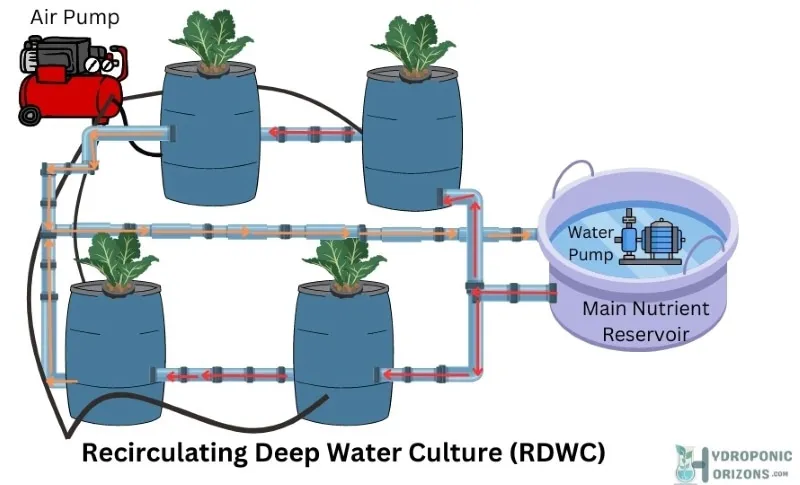
Components and Setup
When comparing DWC and RDWC systems, it’s essential to understand the components and setup involved in both systems. In this section, we’ll discuss the key elements and their roles, including containers and reservoirs, air pumps and air stones, tubing and piping, nutrient solution, and temperature management.
Containers and Reservoirs
In a DWC system, you will need a single container to house both your plants and the nutrient solution. On the other hand, a DWC Recirculating system comprises multiple containers connected to a central reservoir that holds the nutrient solution. This central reservoir helps manage the water and nutrient feeding across all plant containers for an even distribution.
Air Pumps and Air Stones
Both DWC and RDWC systems require air pumps and airstones to ensure proper oxygenation for your plants’ roots. In a DWC system, an air pump pushes air through air stones placed within the container. In an RDWC hydroponic system, there is a centralized air pump for several grow sites with air stones placed in each container, ensuring sufficient oxygenation throughout the entire system.
Tubing and Piping
While DWC systems don’t have connecting pipes between the buckets, RDWC systems use tubing and piping to circulate the nutrient solution from the reservoir to each plant container. The circulation maintains uniform nutrient distribution and a consistent water temperature throughout the system.
Nutrient Solution
The nutrient solution used in both DWC and RDWC systems consists of water mixed with hydroponic nutrients, formulated to provide optimal growth conditions for your plants. Managing nutrient solution levels and mixing is crucial for maintaining plant health and preventing nutrient imbalances or deficiencies.
Temperature
Controlling water temperature is vital for both systems, as it affects nutrient absorption and root health. DWC systems can be more prone to fluctuations due to the lack of a central reservoir, while RDWC systems generally have a better thermal mass effect, resulting in more stable temperatures. It is essential to monitor and maintain the temperature within the optimal range advised for your chosen plants.
In conclusion, understanding the components and setup of DWC and RDWC systems helps you make an informed decision on which method best meets your needs, allowing you to optimize growth and maintain a healthy hydroponic garden. To decide which method is best for your needs, consider factors like space, budget, experience, and the type of plants you’re planning to grow.
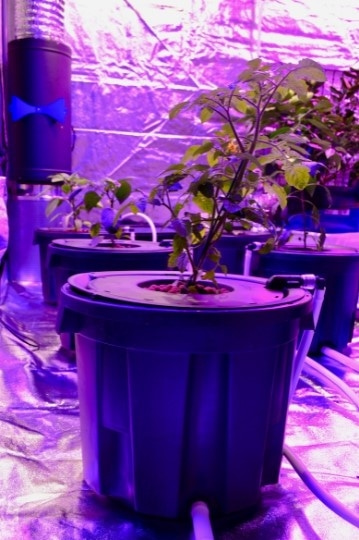
Maintaining DWC and RDWC Systems
Nutrient Uptake and Feeding
In both DWC (Deep Water Culture) and RDWC (Recirculating Deep Water Culture) systems, plants receive nutrients through their roots submerged in nutrient-rich water. To promote optimal growth, you need to ensure a balanced nutrient supply and feeding schedule.
- Regularly check and adjust nutrient concentration for your specific plant species.
- Observe the plants’ responses, such as leaves and stem coloration, and adjust nutrients accordingly.
- Replace the nutrient solution in DWC systems every 7-10 days. In RDWC systems, nutrient monitoring should be more frequent, as the recirculation may cause nutrient imbalances.
Monitoring pH and Oxygen Levels
A key factor in the success of DWC and RDWC systems is maintaining proper pH and dissolved oxygen (DO) levels.
- Routinely check pH levels to maintain a range of 5.5-6.5, which is optimal for most plants.
- Use pH up or down solutions to adjust pH levels as needed.
- Take care of the oxygen supply by ensuring adequate air pump output and using air stones to create bubbles in the water. Bubbleponics is a slight variation in the deep water culture technique where the oxygenated water is delivered by the water pump directly to the plant roots from above.
Water Temperature and Chiller
Controlling water temperature is crucial for both DWC and RDWC systems, especially when the grow buckets are larger or the environment is warmer than ideal.
- Keep the water temperature between 18-20°C (65-68°F).
- Use a water chiller if you have difficulty maintaining proper water temperature.
- For RDWC systems, consider using a larger main reservoir to take advantage of the thermal mass effect which can help stabilize the water temperature.
Algae Control and Prevention
Algae can hinder your plants’ growth and affect yield by reducing the availability of oxygen and nutrients. Here are some tips to prevent and control algae in your DWC and RDWC systems:
- Block light from entering your grow buckets by using dark-colored containers or insulating your grow rooms.
- Maintain proper nutrient balance, as this can reduce the chances of algae growth.
- Gently clean your containers and all equipment periodically with mild, plant-safe disinfectants.
By following these guidelines, you’ll be able to maintain your DWC and RDWC systems effectively, leading to healthy plant growth and impressive yields.
Comparing DWC and RDWC
RDWC Vs DWC Yield and Growth Rate
In a DWC (Deep Water Culture) system, plant roots are submerged in a nutrient-rich, oxygenated solution, promoting faster growth and higher yields. RDWC (Recirculating Deep Water Culture) systems operate similarly but with the added benefit of constantly recycling and aerating the nutrient solution, ensuring optimal oxygen and nutrient levels for even faster growth and larger yields.
Price and Equipment Requirements
When considering cost, a DWC setup is typically more affordable since it requires fewer components. However, if you’re looking to expand and grow more plants while still maintaining optimal nutrient uptake, recirculating DWC system may be a better choice, despite its added complexity and higher equipment costs, since you will be reusing water.
Disease and Pest Management
In hydroponic systems such as DWC and RDWC, disease and pest management are crucial to maintaining healthy plants. Both systems can benefit from the introduction of beneficial bacteria and microbes to improve nutrient uptake and root health. However, RDWC systems may have a slight edge when it comes to disease management, as constantly recycling the nutrient solution helps to maintain a more stable environment less conducive to pathogens. It is also easier to isolate diseased plants by removing the affected grow site from the larger system.
Maintenance and DIY Options
While both DWC and RDWC systems require regular maintenance to ensure optimal nutrient levels, RDWC systems may be more demanding in terms of monitoring and fine-tuning, but balancing of nutrients and testing for pH is easier. Nevertheless, if you’re interested in DIY options, RDWC systems can be customized to fit your specific needs and preferences. This flexibility allows you to create a more efficient system tailored to your growing space, ultimately contributing to greater productivity and healthier plants.
Keep in mind that you can only grow one type of plant per contained RDWC system with one main reservoir, as each type of crop or even strain will require a separate nutrient solution. If you want to grow several batches of different crops, then each nutrient reservoir can be maintained separately in a simple DWC system.
Choosing the Right System
When it comes to hydroponic growing, you may find yourself trying to decide between using a DWC (Deep Water Culture) setup or an RDWC (Recirculating Deep Water Culture) system. Both of these setups have their pros and cons, and, based on your specific situation, one may be better suited for your needs than the other. In this section, we will discuss some factors to consider when choosing between DWC and RDWC systems.
Factors to Consider
- Plant Growth Rate: DWC systems can lead to faster plant growth due to the constant supply of water and nutrients, as the roots are constantly submerged in the nutrient solution. On the other hand, in RDWC systems, the roots are only submerged part of the time, which potentially reduces the risk of root rot but may result in a slightly slower growth rate.
- System Complexity: While RDWC systems offer increased flexibility and better nutrient management, they can be more complex and require more maintenance than their simpler DWC counterparts. You will need to closely monitor and maintain the right conditions in effective recirculation.
- Size of your Grow Space: In RDWC systems, larger containers should be used to accommodate your plants and allow plenty of space for roots to grow. Consider the available space in your grow room and the number of plants you plan to cultivate when deciding on a system. If you have limited space, a DWC system might be a better choice for your needs source.
- Economy: Generally, RDWC systems can be more expensive than DWC systems due to the additional equipment and complexity involved. However, you should also take into account the potential for increased yield and reduced risk of root disease when evaluating the overall cost-effectiveness source
When it comes to DWC and RDWC systems, carefully weigh the pros and cons based on your specific situation before making a decision. Factors like plant growth rate, system complexity, economics, and available space can impact the type of system that is perfect for you. Remember that no matter which system you choose, monitoring and maintaining optimal growing conditions is a constant task, which will lead you to successfully growing your hydroponic plants.
RDWC Kit
Most commercially available recirculating hydroponic kits are not true RDWC setups where the nutrient water is pumped directly into the water table inside the grow bucket. Instead, you’re more likely to come across a top drip feed system, also known as the Dutch Bucket system, where the nutrient water is fed to each plant growing in a bucket from the top, while the used water is recirculated back to the main reservoir from the bottom of the buckets.
We go into the Dutch bucket system in more detail in a separate post, but if you want a true complete RDWC kit, then the MAOPINER Deep Water Culture Hydroponic Bucket Kit is the best RDWC system to buy.
MAOPINER Deep Water Culture Hydroponic Bucket Kit with Air Pump
This hydroponics growing system kit promotes faster plant growth by fully oxygenating them with an airstone.
It’s easy to assemble with everything included, and the clay pebbles provide solid root support. Suitable for indoor growing of herbs, vegetables, and fruits.
The kit includes four 5.28 Gallon/20L hydroponic barrels, one main reservoir barrel, an air pump, clay pebbles, air pipe, black feeding hose, air stone components, visual water level group, valve connection, and instructions.
Related: What is the best DWC system to buy? Take a look at our top picks on the market.
DIY Recirculating Deep Water Culture
Want to learn how to build a recirculating deep water culture system instead of buying a kit? You will need the following equipment first:
- Buckets / containers
- Reservoir
- Net pots
- Air pump
- Air tubing
- Air stones
- Multiple pipe fittings and connectors
- PVC pipe or vinyl tubing
- Water pump
After assembling an RDWC system, you should fill it up cautiously to check for leaks and fix any loose connections before planting your garden. When finished testing, drain the water and refill it before positioning the plants.
Related: Another design for a recirculating drip hydroponic system involves a more traditional setup where a grow tray is used to house several plants rather than a bucket for each one.
Is it Easy to Convert DWC To RDWC?
Yes, it is relatively easy to convert a DWC hydroponic system to an RDWC hydroponic system. The process involves adding additional buckets or containers to the system, connecting them with tubing, and adding a water pump to recirculate the water between the buckets. However, the exact process may vary depending on the specific system and components being used, so it’s important to carefully research and follow instructions or seek guidance from an experienced hydroponic gardener.
You can also just as easily convert a DWC system to a Dutch Bucket system where there is no need for an air pump and air stones, as each separate bucket is filled with an inert grow material instead of nutrient water. Instead of feeding water from the main reservoir into each plant container, it is fed by a drip irrigation system from the top. Both methods recirculate spent water back to the reservoir for nutrient replenishment.


